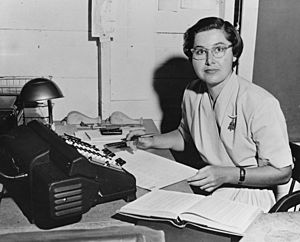Elizabeth Roemer facts for kids
Elizabeth "Pat" Roemer (born September 4, 1929 – died April 8, 2016) was an American astronomer and teacher. She loved studying space, especially comets and small planets called asteroids. Pat Roemer was famous for finding "lost" comets that scientists couldn't track anymore. She also discovered two asteroids and helped find Jupiter's moon, Themisto. An asteroid, 1657 Roemera, was even named after her!
Contents
Early Life and Education
Elizabeth Roemer was born in Oakland, California, on September 4, 1929. She grew up in Alameda, California, with her parents. From a young age, Pat was very curious about science and space.
Discovering a Passion for Astronomy
When she was in high school during World War II, many teachers had temporary licenses. Pat noticed that one of her science teachers made mistakes about astronomy. For example, the teacher said Polaris was the biggest star. Pat didn't have books to check, but she was encouraged to find the right answers. She contacted someone in the Astronomy Department at Berkeley who helped her. This experience sparked her deep interest in astronomy.
College and Early Career
In 1946, Pat graduated at the top of her high school class. That same year, she won the National Westinghouse Science Talent Search. She became a serious amateur astronomer, eager to study comets and asteroids. In 1950, she earned her degree in astronomy from the University of California, Berkeley. She graduated with honors.
While studying for her advanced degree, Pat taught adult classes in Oakland. This helped her pay for college and also made her love teaching. From 1954 to 1955, she worked at UC's Lick Observatory. In 1955, she earned her PhD from Berkeley.
Career as an Astronomer
After getting her PhD, Pat Roemer continued her research. She worked at the University of Chicago’s Yerkes Observatory. In 1957, she became an astronomer at the US Naval Observatory in Flagstaff, Arizona.
Finding Lost Comets
Pat became well-known for finding comets that had gone missing. She used a powerful 40-inch telescope to take pictures and study the centers of comets. Her amazing work led to finding dozens of "short-period" comets. These are comets that take less than 20 years to orbit the Sun.
At that time, scientists found it hard to track these comets. They would get "lost" as they moved too far from Earth. Pat found these lost comets by looking in the areas where they were expected to be. She looked for tiny movements compared to nearby stars. This was very difficult because predicting a comet's exact position and brightness was tough. Pat's detailed measurements helped astronomers track many short-period comets, even to this day.
Teaching and Leadership Roles
In 1965, Pat became the acting director at the US Naval Observatory. The University of Arizona hired her in 1966 as a professor in the lunar and planetary laboratory. By 1969, she became a full professor. In 1972, she helped create the university's Department of Planetary Sciences.
In 1980, while still a professor, she also worked as an astronomer at Tucson’s Steward Observatory. She stayed there until 1997. Pat Roemer retired in 1998 but kept researching comets and asteroids as a professor emerita. She passed away on April 8, 2016, in Tucson, Arizona.
Major Discoveries and Achievements
Pat Roemer made many important contributions to astronomy.
- In 1961, an asteroid was named in her honor: 1657 Roemera.
- She discovered the asteroid 1930 Lucifer on October 29, 1964.
- She also discovered the asteroid 1983 Bok on June 9, 1975.
- In 1975, she helped discover Jupiter’s moon, Themisto, with Charles T. Kowal. Themisto was lost for a while but was found again in 2000.
- Throughout her career, Pat found 79 returning periodic comets. She also calculated the paths of many comets and minor planets.
Awards and Recognition
Elizabeth Roemer received several awards for her work.
- She won the BA Gould Prize from the National Academy of Sciences.
- She received the NASA Special Award.
- She was given the Donohoe Lectureship by the Astronomical Society of the Pacific.
- In 1960, Mademoiselle Magazine named her one of its "Ten Young Women of the Year." Pat hoped this award would inspire other young women to explore astronomy.
Legacy and Impact
Elizabeth Roemer was an active and important member of the astronomy community until her death in 2016. She joined the Friends of Lowell Observatory in 2006. Before she died, she made a generous donation. This money created the Elizabeth Roemer Foundation Donation. It helps fund new equipment and technology at the Lowell Observatory. Her support helps keep the observatory's tools working well and safely.
See also
In Spanish: Elizabeth Roemer para niños


